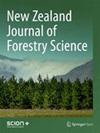新西兰森林蜜环菌种的个体分化
IF 1.1
4区 农林科学
Q2 FORESTRY
引用次数: 0
摘要
背景:在新西兰的原生森林中,新蜜环菌和柠檬菌作为木材腐朽真菌自然存在。作为病原体,它们对种植园、作物、城市公园和花园中的树木和灌木的严重根病负有责任。彻底了解它们的种群动态需要了解它们各自菌丝体或基因的空间排列。在以前的工作中,这些真菌的营养亲和群(VCG)的分布是在幼龄辐射松人工林取代之前和之后在原生森林区域绘制的。随着分子技术的出现,可以使用培养技术测试早期产生的物种身份,并验证由配对培养物之间的不相容反应确定的VCG是否代表不同的个体基因。方法:从储存中回收代表每个VCG的分离株的库存亚培养物,以获得DNA。使用11个通用引物对提取的DNA进行聚合酶链式反应程序(UP-PCR),以评估亚培养物之间的遗传变异。对每个引物-亚培养组合的条带进行评分为存在或不存在,并通过生成树状图树进行聚类分析,以揭示亚培养之间的遗传分组。结果:DNA聚类分析将分离株的亚培养物分为两个类群,即泽兰A.novae和柠檬A.limonea,对应于通过培养形态学确定的身份。在物种内,亚培养物分组为与早期培养配对确定的VCG相匹配的集群。除了一个由两个亚群组成的褐藻外,VCG内几乎没有遗传变异的迹象。结论:实验室培养技术鉴定的蜜环菌种和VCG通过独立的分子方法进行了验证。一般来说,VCG代表该领域中离散的单个基因或群体。基于DNA序列差异区分分离株的技术为解决种群空间结构提供了一种快速的替代耗时的实验室培养方法。然而,在合理化树状图树中分组的重要性时,一些互补的孤立配对可能是必要的。本文章由计算机程序翻译,如有差异,请以英文原文为准。
Differentiating individuals of Armillaria species in New Zealand forests
Background: Armillaria novae-zelandiae and A. limonea occur naturally as wood decay fungi in native forests in New Zealand. As pathogens they are responsible for significant root disease in trees and shrubs in plantations, crops and urban parks and gardens. A thorough understanding of their population dynamics entails knowledge of the spatial arrangement of their individual mycelia or genets. In previous work the distributions of vegetative compatibility groups (VCGs) of these fungi were mapped in an area of native forest prior to and after replacement by a young Pinus radiata plantation. With the advent of molecular technology, it has become possible to test species identities made earlier using culture techniques and to verify whether or not their VCGs, determined by incompatibility reactions between paired cultures, represent distinct individual genets.
Methods: Stock subcultures of isolates representing each VCG were recovered from storage in order to obtain DNA. Extracted DNA was subjected to a polymerase chain reaction procedure (UP-PCR) using 11 universal primers to assess genetic variation between subcultures. Bands were scored as either present or absent for each primer-subculture combination and cluster analysis was undertaken by generating dendrogram trees to reveal genetic groupings among subcultures.
Results: DNA cluster analysis divided subcultures of isolates into two species groups, A. novae-zelandiae and A. limonea, corresponding to identities determined through culture morphology. Within species, subcultures grouped into clusters that matched VCGs determined by earlier culture pairing. There was little indication of genetic variation within VCGs, except for one of A. limonea, which comprised two sub-clusters.
Conclusions: The Armillaria species and VCGs identified by culture techniques in the laboratory were verified by independent molecular methodology. In general, the VCGs represent discrete individual genets or colonies in the field. Techniques that differentiate isolates based on differences in their DNA sequence provide a quick alternative to time-consuming laboratory culture methods for resolving population spatial structure. However, some complementary isolate pairing may be necessary when rationalising the significance of groupings in dendrogram trees.
求助全文
通过发布文献求助,成功后即可免费获取论文全文。
去求助
来源期刊

New Zealand Journal of Forestry Science
FORESTRY-
CiteScore
2.20
自引率
13.30%
发文量
20
审稿时长
39 weeks
期刊介绍:
The New Zealand Journal of Forestry Science is an international journal covering the breadth of forestry science. Planted forests are a particular focus but manuscripts on a wide range of forestry topics will also be considered. The journal''s scope covers forestry species, which are those capable of reaching at least five metres in height at maturity in the place they are located, but not grown or managed primarily for fruit or nut production.
 求助内容:
求助内容: 应助结果提醒方式:
应助结果提醒方式:


